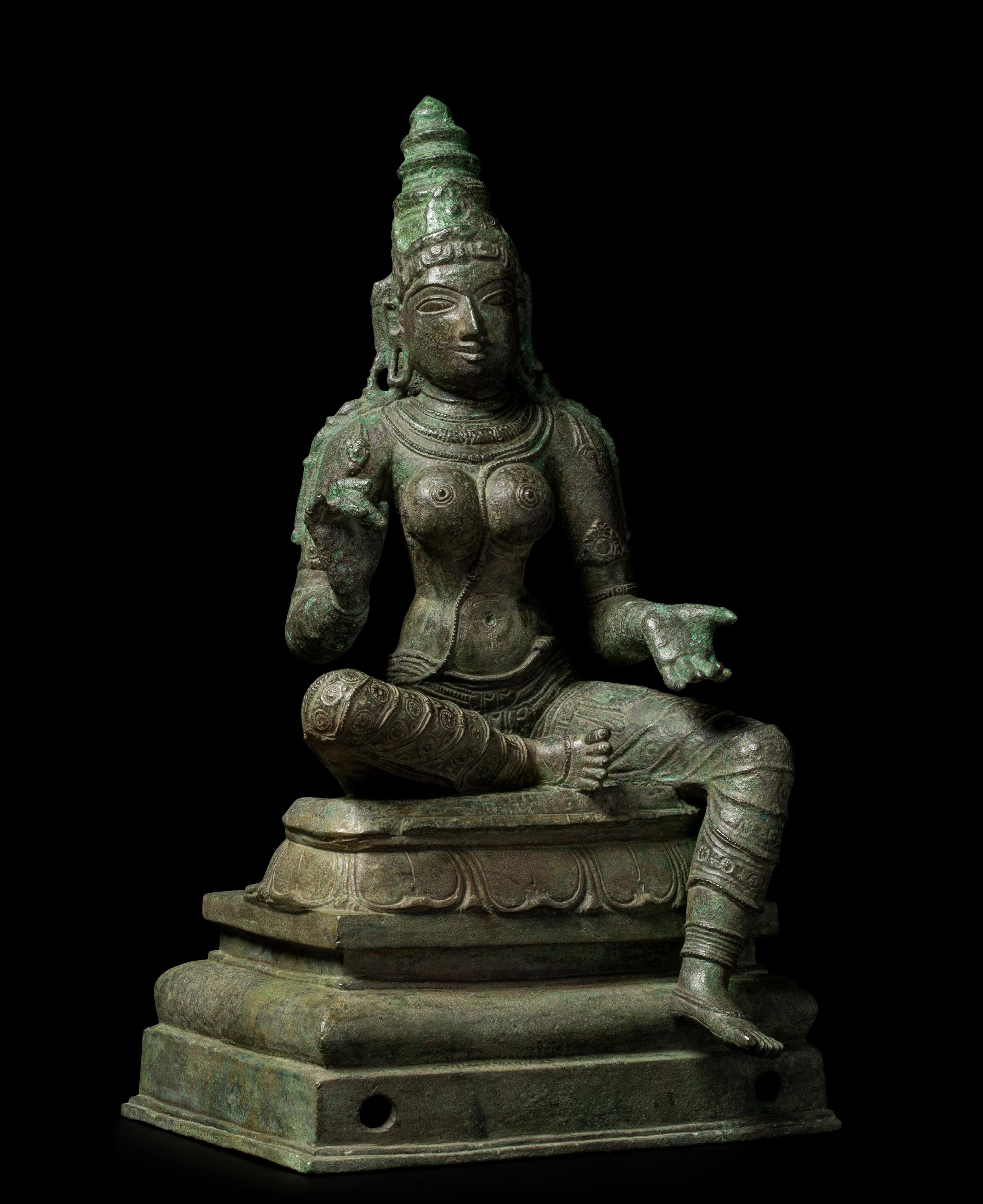
2 minute read
Uma (Parvati)
South India, Tamil Nadu, Chola period, 11th-12th century
Copper Alloy
15 x 8 ½ in. (38.1 x 21.5 cm.)
Provenance:
The estate of Kelly Brook, acquired in India in the 1950s.
Galleria Ethnologica, Forli, Italy, 2011.
Uma appears graceful yet powerful upon a tiered lotus throne. A crown surmounts her discreetly smiling face, modeled with wide eyes, a sharp nose and full lips. Her sacred thread, or yajnopavita, guides the eye from her neck down her voluptuous torso and soft belly to her lap, where her beautifully detailed skirt covers her legs to her mid-calf, below which multi-banded anklets and beaded ornaments decorate her down to her feet. She sits in lalitasana, the ‘posture of royal ease,’ with one leg retracted and the other hanging relaxedly off of her throne.
Most images of Parvati in this seated posture belong to a larger group referred to as ‘Somaskanda,’ which describes the divine family constituted by Shiva, Parvati and Skanda. The present figure of Parvati, or ‘Uma’ in the native language of Tamil Nadu, was almost certainly part of a larger group of sculptures which served an essential role in a Shaivite temple centuries ago.
“According to Shaiva Siddhanta philosophy, only when he is in the company of his consort Uma does Shiva bestow grace upon an individual soul. A metal image of the god together with Uma and their son Skanda is thus the principal image of such individual grace, and every single temple, wealthy or otherwise possesses a Somaskanda image. ( V. Dehejia, The Sensuous and the Sacred: Chola Bronzes of South India, New York, 2002, p.128.).” The image is of such great importance that it may be used as a substitute for any godly image needed for Hindu worship. While the present sculpture, like most figures of its size, was commissioned for and essential for temple worship, the group of three portable bronze images were also processional. Such is indicated by the holes fit for poles seen here, which enable worshippers to carry the divine figures into the streets for all to experience darshan—to meet the gaze of the divine.
There are instances in which bronze Somaskanda images were cast as a whole as well as instances in which they have been cast separately, while intended to be experienced together. One instance of a separately-cast Somaskanda group, such as that from which the present originates, can be found at the Puran Vitankar Temple in Tirumangalakudi, dated circa-1100 by Dehejia (see ibid, p.128, fig. 1). The present figure of Uma, however, differs from this one stylistically.
The eleventh or twelfth century date for the present figure is supported by the crown style, which follows that of Parvati’s in a well known group depicting the marriage of Shiva and Parvati from the Tiruvenkadu temple, circa 1012, now in the Tanjore Art Gallery (see V. Dehejia, Art of the Imperial Cholas, New York, 1990, p. 72, fig. 55). The three tiers of the conical crown and the central ornamented petal, as well as the simple layered necklaces and arm bands framing her buoyant breasts with articulated nipples, however, more closely matches that of a Somaskanda image of Parvati at the Shiva Temple in Paundarikapuram attributed to the late twelfth century (see V. Dehejia, The Sensous and the Sacred: Chola Bronzes of South India, New York, 2002, p. 43, fig. 22). Moreover, the absence of the three distinct lines above Uma’s abdomen (trivali tarangini), a later Chola convention, supports the early dating of this bronze.









